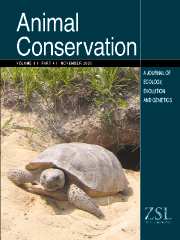Crossref Citations
This article has been cited by the following publications. This list is generated based on data provided by
Crossref.
Nakazawa, Yoshinori
Peterson, A. Townsend
Martínez-Meyer, Enrique
and
Navarro-Sigüenza, Adolfo G.
2004.
SEASONAL NICHES OF NEARCTIC-NEOTROPICAL MIGRATORY BIRDS: IMPLICATIONS FOR THE EVOLUTION OF MIGRATION.
The Auk,
Vol. 121,
Issue. 2,
p.
610.
Roura-Pascual, Núria
Suarez, Andrew V.
Gómez, Crisanto
Pons, Pere
Touyama, Yoshifumi
Wild, Alexander L.
and
Peterson, A. Townsend
2004.
Geographical potential of Argentine ants (Linepithema humileMayr) in the face of global climate change.
Proceedings of the Royal Society of London. Series B: Biological Sciences,
Vol. 271,
Issue. 1557,
p.
2527.
Nakazawa, Yoshinori
Peterson, A. Townsend
Martínez-Meyer, Enrique
and
Navarro-Sigüenza, Adolfo G.
2004.
SEASONAL NICHES OF NEARCTIC-NEOTROPICAL MIGRATORY BIRDS: IMPLICATIONS FOR THE EVOLUTION OF MIGRATION.
The Auk,
Vol. 121,
Issue. 2,
p.
610.
Illoldi-Rangel, Patricia
Sánchez-Cordero, Víctor
and
Townsend Peterson, A.
2004.
PREDICTING DISTRIBUTIONS OF MEXICAN MAMMALS USING ECOLOGICAL NICHE MODELING.
Journal of Mammalogy,
Vol. 85,
Issue. 4,
p.
658.
Ortega‐Huerta, Miguel A.
and
Peterson, A. T.
2004.
Modelling spatial patterns of biodiversity for conservation prioritization in North‐eastern Mexico.
Diversity and Distributions,
Vol. 10,
Issue. 1,
p.
39.
TOWNSEND PETERSON, A.
and
SCACHETTI-PEREIRA, R.
2004.
Potential Geographic Distribution of Anoplophora glabripennis (Coleoptera: Cerambycidae) in North America.
The American Midland Naturalist,
Vol. 151,
Issue. 1,
p.
170.
Peterson, A. Townsend
Martínez‐Meyer, Enrique
and
González‐Salazar, Constantino
2004.
Reconstructing the Pleistocene geography of the Aphelocoma jays (Corvidae).
Diversity and Distributions,
Vol. 10,
Issue. 4,
p.
237.
Anderson, Robert P.
and
Martı&#x;nez-Meyer, Enrique
2004.
Modeling species’ geographic distributions for preliminary conservation assessments: an implementation with the spiny pocket mice (Heteromys) of Ecuador.
Biological Conservation,
Vol. 116,
Issue. 2,
p.
167.
Nakazawa, Yoshinori
Peterson, A. Townsend
Martínez-Meyer, Enrique
and
Navarro-Sigüenza, Adolfo G.
2004.
SEASONAL NICHES OF NEARCTIC-NEOTROPICAL MIGRATORY BIRDS: IMPLICATIONS FOR THE EVOLUTION OF MIGRATION.
The Auk,
Vol. 121,
Issue. 2,
p.
610.
ARRIAGA, LAURA
CASTELLANOS, ALEJANDRO E.
MORENO, ELIZABETH
and
ALARCÓN, JESÚS
2004.
Potential Ecological Distribution of Alien Invasive Species and Risk Assessment: a Case Study of Buffel Grass in Arid Regions of Mexico.
Conservation Biology,
Vol. 18,
Issue. 6,
p.
1504.
Bauer, John T.
and
Peterson, A. Townsend
2005.
Visualizing environmental correlates of species geographical range limits.
Diversity and Distributions,
Vol. 11,
Issue. 4,
p.
275.
Peterson, A. Townsend
and
Jones, Cheri A.
2005.
KANSAS GAP ANALYSIS: THE IMPORTANCE OF VALIDATING DISTRIBUTIONAL MODELS BEFORE USING THEM.
The Southwestern Naturalist,
Vol. 50,
Issue. 2,
p.
230.
Sánchez-Cordero, Víctor
Illoldi-Rangel, Patricia
Linaje, Miguel
Sarkar, Sahotra
and
Peterson, A. Townsend
2005.
Deforestation and extant distributions of Mexican endemic mammals.
Biological Conservation,
Vol. 126,
Issue. 4,
p.
465.
Peterson, A. Townsend
Martínez-Campos, Carmen
Nakazawa, Yoshinori
and
Martínez-Meyer, Enrique
2005.
Time-specific ecological niche modeling predicts spatial dynamics of vector insects and human dengue cases.
Transactions of the Royal Society of Tropical Medicine and Hygiene,
Vol. 99,
Issue. 9,
p.
647.
Phillips, Steven J.
Anderson, Robert P.
and
Schapire, Robert E.
2006.
Maximum entropy modeling of species geographic distributions.
Ecological Modelling,
Vol. 190,
Issue. 3-4,
p.
231.
Beissinger, Steven R.
Walters, Jeffrey R.
Catanzaro, Donald G.
Smith, Kimberly G.
Dunning,, John B.
Haig, Susan M.
Noon, Barry R.
and
Stith, Bradley M.
2006.
Modeling Approaches in Avian Conservation and the Role of Field Biologists.
Ornithological Monographs,
p.
iii.
Peterson, A. Townsend
Sánchez-Cordero, Victor
Martínez-Meyer, Enrique
and
Navarro-Sigüenza, Adolfo G.
2006.
Tracking population extirpations via melding ecological niche modeling with land-cover information.
Ecological Modelling,
Vol. 195,
Issue. 3-4,
p.
229.
García, Andrés
2006.
Using ecological niche modelling to identify diversity hotspots for the herpetofauna of Pacific lowlands and adjacent interior valleys of Mexico.
Biological Conservation,
Vol. 130,
Issue. 1,
p.
25.
Rodríguez, Jon Paul
Brotons, Lluís
Bustamante, Javier
and
Seoane, Javier
2007.
The application of predictive modelling of species distribution to biodiversity conservation.
Diversity and Distributions,
Vol. 13,
Issue. 3,
p.
243.
Papeş, M.
and
Gaubert, P.
2007.
Modelling ecological niches from low numbers of occurrences: assessment of the conservation status of poorly known viverrids (Mammalia, Carnivora) across two continents.
Diversity and Distributions,
Vol. 13,
Issue. 6,
p.
890.


